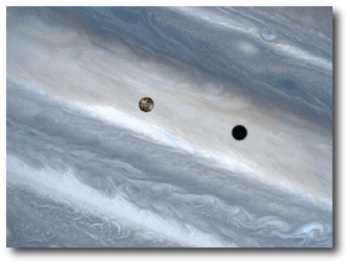
Man! Like everyone else over the past 24 hours, I’ve been thinking about that new crop of Superearths.
The conventional wisdom (over which I was waxing enthusiastic a mere 36 hours ago) holds that Mayor’s new population of planets are essentially failed giant planet cores which began forming at considerably larger radii in the protostellar disk and then experienced significant inward migration as they built themselves up. In this scenario, the Superearths arise from more or less the same sort of process (but with a different outcome) that formed the giant planets in our own solar system.
What’s struck me, however, is the odd resemblance between a multiple-planet system like HD 40307 and the regular satellite systems of the Jovian planets. In both cases, the characteristic orbital period is of order a week, and the system mass ratio (satellites-to-central-body) is of order 2 parts in 10,000.
In the Ward-Canup theory, the regular satellites of the Jovian planets are thought to have formed more or less in situ in gas-starved disks (see here for more discussion). If the new population of planets is somehow the result of an analogous formation process, then they really will be superEarths, as opposed to subNeptunes, and as a consequence, their transit depths will be small.

O/T: the link to the backend from the blog isn’t working: it is currently pointing to http://www.oklo.org/php/login.php instead of http://207.111.201.70/php/backend.php
Pingback: Drei neue Supererden um HD 40307 - SciFi-Forum
Pingback: Astrodicticum Simplex
Hi Andy,
Thanks, I’m in the process of upgrading my wordpress, so there may be a few glitches. In particular, the old redirect is currently down.
http://207.111.201.70/php/backend.php remains the correct link.
best,
Greg